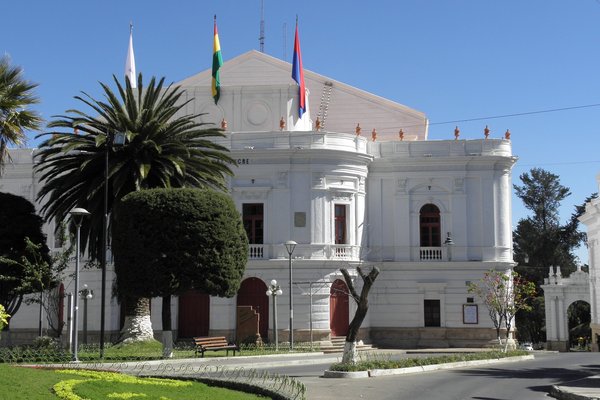Bolivia
Sucre
The Historic City of Sucre is a well-preserved colonial urban landscape that shows the blending of European and local architectural styles.
Sucre became a cultural center, the seat of an archbishopric and the seat of the Supreme Court that reigned over large parts of South America. For much of its colonial history, Sucre's temperate climate was preferred by the wealthy Spanish involved in the silver trade coming from Potosí. Its typical Spanish-colonial checkerboard street pattern is still intact, as are the religious and public buildings from the 16th to 19th centuries.
Community Perspective: An attractive, relaxed city and with a climate comparable to a British colonial hill-town, Sucre is considered a good place to spend a few nights. It can be hard though to find anything open (especially the churches). The Casa de Libertad is a must-do, and good city views are to be had from the roofs of the San Felipe Neri church and La Recoleta. Furthermore, Timonator recommends a Free Walking Tour and the indigenous textile museum, Nan the Gutierrez Museum.
Site Info
Official Information
- Full Name
- Historic City of Sucre (ID: 566)
- Country
- Bolivia
- Status
-
Inscribed 1991
Site history
History of Sucre
- 1991: Inscribed
- Inscribed
- Type
- Cultural
- Criteria
- iv
Links
- UNESCO
- whc.unesco.org
- Official
-
- boliviaturismo.com.bo — Bolivia Turismo
- Related
-
- turismosucre.com — Turismo Sucre
All Links
UNESCO.org
- whc.unesco.org — whc.unesco.org/
Official Website
- boliviaturismo.com.bo — Bolivia Turismo
Related Resources
- turismosucre.com — Turismo Sucre
Community Information
- Community Category
- Urban landscape: Colonial
Travel Information
Recent Connections
-
Perfect Inscriptions
1991 -
Río de la Plata Basin
On the Cachimayu which flows into the P… -
Cemeteries
Cementerio GeneralSee es.wikipedia.org
Connections of Sucre
- Geography
-
-
Andes
(2750 mtrs) -
Located in a Capital City
Sucre (constitutional capital of Bolivia) -
Río de la Plata Basin
On the Cachimayu which flows into the Pilcomayu and thence to the Paraguay/Parana -
Highest cultural WHS
2,750 m
-
- Trivia
-
-
Dubbed 'White City'
La Ciudad Blanca -
Built or owned by Spanish
On November 30, 1538, Sucre was founded under the name Ciudad de la Plata de la Nueva Toledo (City of Silver of New Toledo) by Pedro Anzures, Marquís de Campo Redondo. (wiki)
-
- History
-
-
Declarations of Independence
At the "Casa de la Libertad" the Declaration of Independence of Bolivia was signed on August 6th, 1825.
-
- Architecture
-
-
Designed by Gustave Eiffel
A small Eiffel-tower lookalike in Parcque Bolivar is attributed to him -
Mudejar style
Iglesia de San Francisco - ceiling -
Neoclassical architecture
late 18th, early 19th century buildings in a style brought from metropolitan Spain (AB ev)
-
- World Heritage Process
-
-
Inscribed on a single criterion only
iv. to be an outstanding example of a type of building, architectural or technological ensemble or landscape which illustrates (a) significant stage(s) in human history -
Perfect Inscriptions
1991
-
- Religion and Belief
-
-
Cathedrals
Cath-Basil de N Senora de Guad -
Jesuit Order
Convent of the Jesuits
-
- Constructions
-
-
Cemeteries
Cementerio GeneralSee es.wikipedia.org
-
- WHS on Other Lists
-
-
Memory of the World
Documentary Fonds of Royal Audiencia Court of La Plata (RALP)
-
- Timeline
-
-
Built in the 16th century
founded in 1538
-
- Science and Technology
-
-
Universities
Sucre's University (Universidad Mayor Real & Pontificia de San Francisco Xavier de Chuquisaca) is one of the oldest universities in the new world (1624) -
Libraries
National Library, holding documents since the 15th century
-
- WHS Names
-
-
Named after individual people
Antonio José de Sucre, South American independence leader
-
News
No news.
Recent Visitors
Visitors of Sucre
- Adrian Turtschi
- Alejandro Lau
- Alexander Parsons
- Ammon Watkins
- Ana
- Angela Vandyck
- Argo
- Atila Ege
- Bamse
- basementonline
- Bill Maurmann
- Bram de Bruin
- Carlos Sotelo
- Chantal den Haan
- chiuliqi
- Christravelblog
- Cirene Moraes
- Claire Bradshaw
- Crinion
- CynthiaSam
- Daniela Hohmann
- edstar500
- Els Slots
- emvcaest
- Erfe91
- Erik Jelinek
- Fan Yibo
- Feldhase
- Fernweh
- Francky D'Hoop
- GabLabCebu
- giloudepuertorico
- Hammeel
- Harald T.
- Harry Mitsidis
- headventure
- hotpickle
- Hunstow
- Iain Jackson
- Jacob Otten
- Jarek Pokrzywnicki
- Jens
- JL
- J_neveryes
- Joel on the Road
- Jon Opol
- KateY
- Kevin247
- Krijn
- La Concy
- Lameduck99
- Liamps91
- Loic Pedras
- Lucio
- Luis Filipe Gaspar
- Lukasz Palczewski
- Maciej Gil
- marcel staron
- Mariam
- maryhattie
- Michael Ayers
- Michael Novins
- Monica66
- Morodhi
- nan
- Niall Sclater
- Nihal Ege
- Palimpsesto
- Patrik
- Pchxiao
- Philipp Leu
- Pieter Dijkshoorn
- Pink Bunny
- Reza
- Roman Bruehwiler
- Ryan Gentry
- RYU
- Sandmann15
- Sergio Arjona
- Shandos Cleaver
- sibariam
- Ssong.x
- Stanislaw Warwas
- stephanvermeulen
- Tcchang0825
- Tevity
- Thomas Buechler
- Thomas van der Walt
- Tim Allen
- Timonator
- Walter
- Weecheng
- Xiquinho Silva
- zfish
- Zoë Sheng
Community Reviews
Show full reviews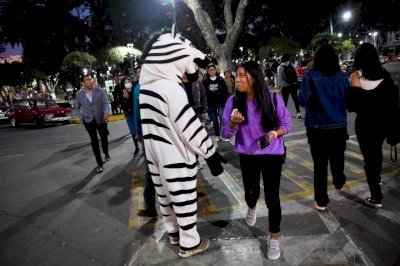
Sucre feels like a de jure capital city, that is to say, a city of civil servants and white-collar professionals. "Laid back" is a phrase you often hear to describe Sucre, and of the four larger cities (Santa Cruz, La Paz, Potosi, and Sucre) that I visited in Bolivia in 2023, I would certainly agree that it felt the most, well, pasteurized. To compare it to the other three cities that I visited, it's prettier than Santa Cruz, less dynamic than La Paz, and less interesting than Potosi. In summary, I liked it much better than Santa Cruz, but little less so than La Paz and Potosi.
Sucre's heart is Plaza de Armas 25 de Mayo. Surrounding the lively and family friendly Plaza are several museums, good number of restaurants, a Cathedral, and people dressed up as zebras. Casa de La Libertad - found on the northwest side of the Plaza - no longer requires you to visit with a guide.
Near Casa de La Libertad is an attractive state government building. I went inside and just kept walking up the various stairways until I arrived at its roof. From the roof, I was then able to access the dome-like structure of the building. Inside this structure was a spiral staircase, which led to a cupola and a small lookout. To be honest, I don't know if a security guard or government worker would have prohibited me from getting to the roof had they seen me. Please also …
Keep reading 0 comments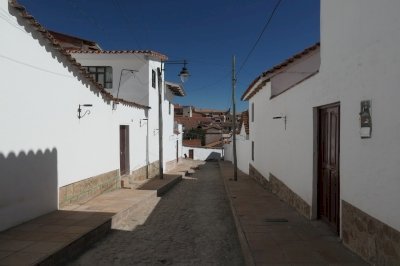
In total I spent 11 nights in Sucre as it's a pleasant city which offers quite som activities and services even though it has a bit of a small town feeling as most places are a small walk from the city center. Some of the white, colonial houses in the city are really nice to look at during day and night and around the central plaza 25 de mayo there is a checkerboard street system. Nevertheless I can understand why some people indicated in their reviews that it's a bit weak to use these properties to make Sucre a WHS. But now that it is a WHS I will rate it not too bad as I have enjoyed my long stay here even though nothing was breathtakingly interesting. In the following I will describe my activities in town and my recommendations. I have visited the cathedral museum which allows you to visit the cathedral's interior. I was too late for the guided tour so I looked at many religious artefacts without explaination. It was interesting to learn that the statue of the Virgen Guadaloupe made among others of diamonds is standing in the chapel next to the cathedral. I only learned it after my visit though. There is a public holiday once per year for the virgin. I can recommend the guided tour that I found via freetourexpert.com that led me to Manu who gave me a really nice free walking tour with facts about the history of the places. …
Keep reading 0 comments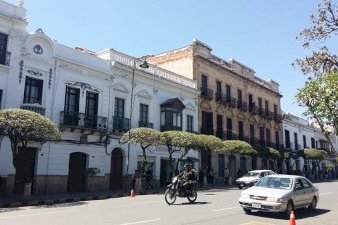
WHS#26
I visited Sucre on my trip to South America in April 2016. I did basically use Sucre as a jump-off point to see sites like Cal Orcko, Potosi, and the Salar de Uyuni. In the end, Sucre kind of fell into the background for me. It's definitely a very pleasant city, one of many great colonial cities in Latin America, but nothing about Sucre really stood out for me. The "White City" (cue my white city syndrome) just didn't impress me, nor was it any prettier than some of the other colonial cities I had visited on the trip. I had just come from Santa Cruz de la Sierra, which wasn't much less pleasant than Sucre, aside from the weather. But before this turns into a ramble, let's discuss the actual experience I had, which wasn't half as bad as it might be looking now.
Flying into Sucre from Santa Cruz was one of the most memorable flights for me because it was only 35 minutes. And in those 35 minutes, you get to see the rainforest below you slowly fade into the mountainous grasslands where Sucre is located, before finally approaching the city itself, which seems to magically appear sprawling on a hilltop. Taking a taxi to the hotel, we were exposed to a bit more of a gritty side of Sucre. A lot of the buildings that aren't so close to the main square seemed to be very rundown or not from the colonial era …
Keep reading 0 comments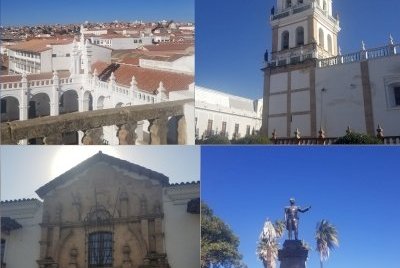
I think Sucre gets a bit of a bad rep because it's "another colonial town" and basically it is. I still liked the town because it grows on you. It's very laid back, there are many foreigners coming here to learn Spanish so you always run into friendly people and start to see familiar faces. When I made Sucre my base for a few days to explore not only the town itself but also the surrounding area I also took advantage to take some Spanish lessons at my hostel.
There was also a big banner that they are planning some celebrations for the 20th anniversary - that's still 2 years to go - but it shows how they really care about the title of being a UNESCO town.
The best view is from the roofs of the San Felipe Neri church. The church itself isn't that great but it's worth it for the view and the sisters were again really, really friendly. Spend a lazy afternoon in the central park where kids like to roam around and everyone else likes to have a rest on the benches.
So I almost feel this place is worthy of the title not for the buildings but for the feel you get.
Keep reading 0 comments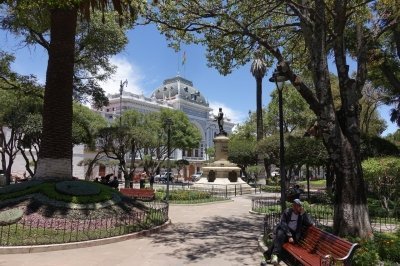
Sucre is one of the prettiest cities in Latin America I have encountered in my travels so far. Immediately when I exited the shared cab from Potosi and stepped out at Parque Simon Bolivar, I was smitten by the white colonial and post colonial buildings that make up the city center. Personally, I would put it near the top along sites as illustrious as San Miguel de Allende and Guanajuato. To me it's second only to Mexico City.
Sucre at 2.500m was a good comprise between the high, dry and cold mining town of Potosi and the tropical cities of the Bolivian lowlands. It felt a bit like those British cities in the mountains of India where they would escape to in summer with their custom made trains. The wealth present in the city at preivous times shows quite strongly. Overall the city gives up a relaxed vibe and I found my time very enjoyable.
I would encourage you to visit the Gutierrez Museum. It shows a little bit the wealth that the upper crust of Bolivian society accumulated in the 19th century, courtesy of the silver mines at Potosi. You should also hike up to La Recoletta for a view of the city.
Getting There and Away
Sucre has an airport connecting to La Paz, Cochabamba and Santa Cruz. The airport is at quite a distance from the city center. Plan 45min or so to get there. A taxi should cost 60 to 80 Bolivianos. …
Keep reading 0 comments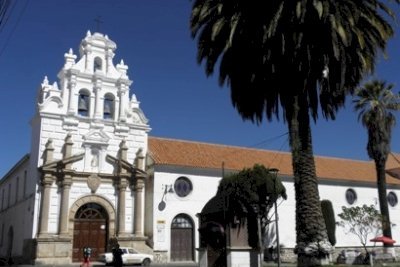
I arrived in Sucre by plane from La Paz on May 25. Little did I know that it was the yearly departmental holiday. Outside of the airport I even ran into the convoy of Presidente Evo Morales, who had made a quick visit to the Bolivian capital from his seat in La Paz. Two things to remember about Sucre: they like their festivities AND they are very proud to still be the official capital of the country.
I stayed for 5 nights in total, mostly to relax a little at a lower altitude than Cuzco and La Paz (where I did not sleep well) and also to visit neighbouring sites Potosi and Cal Orck'o. It's an elegant place, indeed all buildings in the city center are bright white. Seeing the sights of Sucre itself was as problematic as described in the review below by Iain Jackson. Somehow there always was a reason not to be open: the holiday, or just erratic opening hours. I mostly stumbled upon big locks closing the doors of churches and convents.
The most reliable bet is the Casa de La Libertad. Possibly the most interesting place too, as this is where the Bolivians (led by 2 Venezuelans) declared independence. Entrance is via a guided tour only. Mine was led by a very serious guide, showing us the treasures that are so important to his country. And to neighbouring countries as well, as it also holds the first Argentinian flag (both Kirchners had been …
Keep reading 0 comments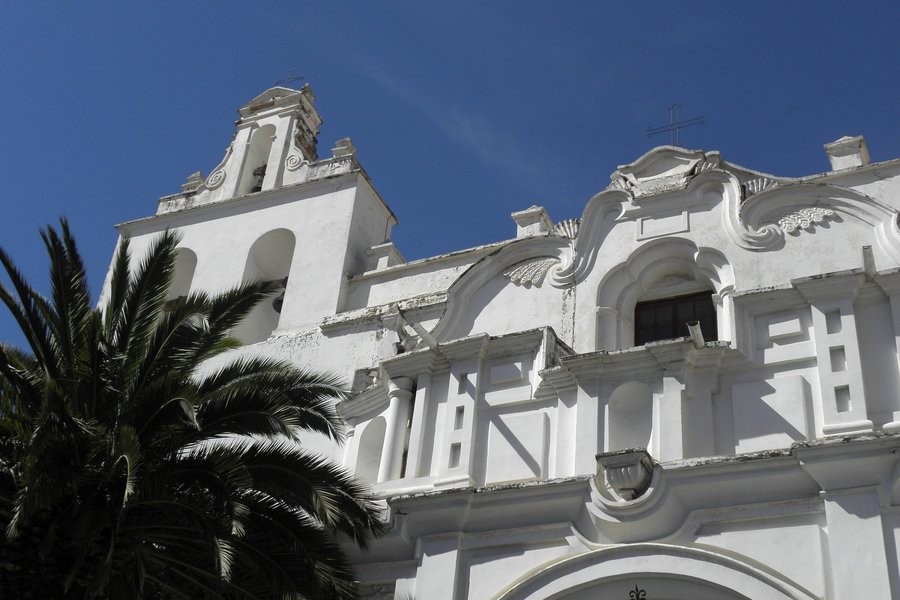
I visited Sucre in March 1993 only 15 months or so after it had been "inscribed" as a WHS. For the preceding 6 weeks or so I had been in low-lying tropical areas and the weather at Sucre's 2790m altitude came as a very pleasant change.
I found it an attractive city with many interesting and buildings and a relaxed atmosphere.
I was very impressed by the Supreme Court. Not so much the building itself, which dates only from 1945, but by the ease with which I could enter and visit, and this in a country where death squads were said to stalk the land and assassination was the preferred method of settling political differences.
On the main square,Plaza 25 de Mayo, are several significant buildings. In the Casa de la Libertad the country's Declaration of Independence was signed and it was treated with appropriate seriousness by the parties of awed schoolkids being shown flags, bloodied clothing and other memorabilia of the struggle for independence.
There is a number of interesting churches in the city centre but I found getting into them quite difficult. They all seemed to have different, and very short, opening hours, with eccentric guardians, who may, or may not, open up at the advertised times.
Try to penetrate the cathedral to see the Virgin of Guadalupe studded with hundreds of amethysts, emeralds, pearls, rubies etc. It was much venerated by campesinos when I was there.
At San Felipe Neri I managed to see the cloisters and …
Keep reading 0 comments
